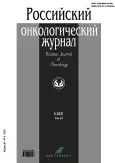Epidemiology of breast cancer in the Krasnoyarsk region
- Authors: Zyuzyukina A.V.1,2, Komissarovа V.А.2, Gasimli D.D.2, Safontsev I.P.1,2, Zukov R.A.1,2
-
Affiliations:
- Prof. V.F. Voino-Yasenetsky Krasnoyarsk State Medical University
- Krasnoyarsk Regional Clinical Cancer Center named after A.I. Kryzhanovsky
- Issue: Vol 26, No 5 (2021)
- Pages: 163-175
- Section: Original Study Articles
- URL: https://journals.rcsi.science/1028-9984/article/view/111757
- DOI: https://doi.org/10.17816/onco111757
- ID: 111757
Cite item
Abstract
AIMS: To assess the epidemiological indicators and the state of oncological care for patients with breast cancer in the Krasnoyarsk Territory from 2011 to 2021.
MATERIALS AND METHODS: The study presents an analysis of data in the Krasnoyarsk Territory from 2011 to 2021.
Data processing was carried out using Microsoft Excel and Statistica 6.0 software products. The correlation between morbidity and mortality was assessed using Spearman’s correlation analysis, and the result was considered statistically significant at a significance level of p <0.05.
RESULTS: An analysis of the incidence of breast cancer in the Krasnoyarsk Territory from 2011 to 2021 showed an increase in the number of cases by 35.2%. The peak incidence falls on the age range of 55–69 years. The mortality rate for the study period tends to decrease; 1-year mortality decreased from 9.3% to 5.1%. The level of early diagnosis increased to 76.4%, while the rate of advanced forms of breast cancer decreased from 33.5% to 23.6%. There is an increase in the number of patients with breast cancer, registered in the dispensary for 5 years or more, from 54.7% to 62.7%, due to the use of modern clinical recommendations, the use of long courses of adjuvant endocrine therapy (up to 10 years), a wide range and frequency of use of antitumor, including targeted drugs.
Correlation analysis between morbidity and mortality rates for the Krasnoyarsk Territory revealed an average, moderate relationship – the correlation coefficient (r=−0.59; p <0.05). A direct average correlation was obtained between the proportion of newly diagnosed cases of breast cancer at stages III and IV and the 1-year mortality rate (r=0.64; p <0.05). A very strong relationship was found between newly diagnosed cases of breast cancer and diseases detected at early stages (r=0.97; p <0.05).
CONCLUSION: The results obtained indicate the effectiveness of ongoing measures for the prevention and early detection of diseases.
Full Text
##article.viewOnOriginalSite##About the authors
Alena V. Zyuzyukina
Prof. V.F. Voino-Yasenetsky Krasnoyarsk State Medical University; Krasnoyarsk Regional Clinical Cancer Center named after A.I. Kryzhanovsky
Author for correspondence.
Email: alena-vz@mail.ru
ORCID iD: 0000-0002-6758-4800
SPIN-code: 6663-3600
Cand. Sci. (Med.), Associate Professor
Russian Federation, Krasnoyarsk; KrasnoyarskValeria А. Komissarovа
Krasnoyarsk Regional Clinical Cancer Center named after A.I. Kryzhanovsky
Email: lera21734tkd@gmail.com
ORCID iD: 0000-0002-5862-1761
SPIN-code: 5808-7020
Statistician
Russian Federation, KrasnoyarskDunya D. Gasimli
Krasnoyarsk Regional Clinical Cancer Center named after A.I. Kryzhanovsky
Email: dgasymly@gmail.com
ORCID iD: 0000-0002-0247-9831
SPIN-code: 2860-9530
Oncologist
Russian Federation, KrasnoyarskIvan P. Safontsev
Prof. V.F. Voino-Yasenetsky Krasnoyarsk State Medical University; Krasnoyarsk Regional Clinical Cancer Center named after A.I. Kryzhanovsky
Email: safoncev@gmail.com
ORCID iD: 0000-0002-8177-6788
SPIN-code: 1548-5565
Cand. Sci. (Med.), Assistant Lecturer
Russian Federation, Krasnoyarsk; KrasnoyarskRuslan A. Zukov
Prof. V.F. Voino-Yasenetsky Krasnoyarsk State Medical University; Krasnoyarsk Regional Clinical Cancer Center named after A.I. Kryzhanovsky
Email: zukov_rus@mail.ru
ORCID iD: 0000-0002-7210-3020
SPIN-code: 3632-8415
Dr. Sci. (Med.), Рrofessor
Russian Federation, Krasnoyarsk; KrasnoyarskReferences
- https://www.who.int/home [Internet]. Breast. Source: Globocan 2020. World Heath Organization; 2020. [cited 2022 Feb 12]. Available from: https://gco.iarc.fr/today/data/factsheets/cancers/20-Breast-fact-sheet.pdf
- Arnold M, Morgan E, Rumgay H, et al. Current and future burden of breast cancer: global statistics for 2020 and 2040. Breast. 2022(66):15–23. doi: 10.1016/j.breast.2022.08.010
- Kaprin AD, Starinskij VV, Shahzadovа AO, editors. Sostojanie onkologicheskoj pomoshhi naseleniju Rossii v 2021 godu. Moscow: MNIOI im. P.A. Gercena – filial FGBU «NMIC radiologii» Minzdrava Rossii; 2022. 239 p. (In Russ).
- Belaya JuA, Zakharova NA, Brentnall AR. Realisation of mammography screening in Khanty-Mansiysk Autonomous State – Yugra. Tumors of Female Reproductive System. 2020;16(3):32–36. (In Russ). doi: 10.17650/1994-4098-2020-16-3-32-36
- Komarova LE, Hasanov RSh, Gamirov RR, et al. Establishing mammographic screening in the Republic of Tatarstan and its first results. Kazan Medical Journal. 2011;92(3):367–371. (In Russ).
- Autier P, Boniol M, La Vecchia C, et al. Disparities in breast cancer mortality trends between 30 European countries: retrospective trend analysis of WHO mortality database. BMJ. 2010;341:c3620. doi: 10.1136/bmj.c3620
- Allemani C, Weir HK, Carreira H, et al. Global surveillance of cancer survival 1995–2009: analysis of individual data for 25,676,887 patients from 279 population-based registries in 67 countries (CONCORD-2). Lancet. 2015;385(9972):977–1010. doi: 10.1016/S0140-6736(14)62038-9
- Cardoso F, Kyriakides S, Ohno S, et al. ESMO Guidelines Committee. Early breast cancer: ESMO Clinical Practice Guidelines for diagnosis, treatment and follow-up. Ann Oncol. 2019;30(10):1674. doi: 10.1093/annonc/mdz189
- Bray F, Ferlay J, Soerjomataram I, et al. Global cancer statistics 2018: GLOBOCAN estimates of incidence and mortality worldwide for 36 cancers in 185 countries. CA Cancer J Clin. 2018;68(6):394–424. doi: 10.3322/caac.21492
- Gøtzsche PC, Nielsen M. Screening for breast cancer with mammography. Cochrane Database Syst Rev. 2011;(1):CD001877. doi: 10.1002/14651858.CD001877.pub4
- Lauby-Secretan B, Scoccianti C, Loomis D, et al. Breast-cancer screening – viewpoint of the IARC Working Group. N Engl J Med. 2015;372(24):2353–2358. doi: 10.1056/NEJMsr1504363
- McTiernan A. Behavioral risk factors in breast cancer: can risk be modified? Oncologist. 2003;8(4):326–334. doi: 10.1634/theoncologist.8-4-326
- Puvanesarajah S, Gapstur SM, Gansler T, et al. Epidemiologic risk factors for in situ and invasive ductal breast cancer among regularly screened postmenopausal women by grade in the Cancer Prevention Study-II Nutrition Cohort. Cancer Causes Control. 2020;31(1):95–103. doi: 10.1007/s10552-019-01253-4
Supplementary files


















